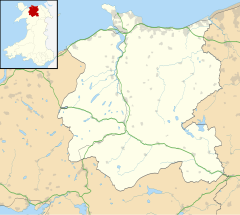Colwyn Bay
Colwyn Bay
|
|
|---|---|
 Colwyn Bay |
|
| Colwyn Bay shown within Conwy | |
| Population | 31,353 (2011) |
| OS grid reference | SH865785 |
| Community |
|
| Principal area | |
| Ceremonial county | |
| Country | Wales |
| Sovereign state | United Kingdom |
| Post town | COLWYN BAY |
| Postcode district | LL29 |
| Postcode district | LL28 |
| Dialling code | 01492 |
| Police | North Wales |
| Fire | North Wales |
| Ambulance | Welsh |
| EU Parliament | Wales |
| UK Parliament | |
| Welsh Assembly | |
Colwyn Bay (Welsh: Bae Colwyn) is a town, community and seaside resort in Conwy County Borough on the north coast of Wales overlooking the Irish Sea. Eight neighbouring communities are incorporated within its postal district. Established as its own separate parish in 1844 with just a small grouping of homes and farms where the community of Old Colwyn stands today, Colwyn Bay has expanded to become the second-largest community and business centre in the north of Wales as well as the 15th largest in the whole of Wales with the urban statistical area having a population of 31,353 at the 2011 census. (Including Old Colwyn, Rhos-on-Sea, Mochdre and Llysfaen communities]. Locally nicknamed "The Bay".
The western side of Colwyn Bay, Rhos-on-Sea, includes a number of historic sites associated with St Trillo and Ednyfed Fychan, the 13th century general and councillor to Llywelyn the Great.
Bay of Colwyn Town Council is a statutory body, covering the communities in the urban area. The mayor for 2016 - 2017 is Councillor John Davies.
The town is situated about halfway along the north coast of Wales, between the sea and the Pwllycrochan Woods on the towering hillside. Groes yn Eirias (Welsh:Cross in Torch) was once a separate hamlet centred on the Glyn farmhouse (c1640) but the area is now occupied by the Glyn estate and Eirias Park.
As with the rest of the British Isles, Colwyn Bay experiences a maritime climate with cool summers and mild winters, and often high winds. The local climate is well known for the prevalence of Foehn winds - where winds from the South pass over the nearby mountains and warm and dry on their descent, leading to far higher temperatures than otherwise might be expected; the area holds the Welsh high temperature record for January, March, August, October, November and December.
...
Wikipedia

